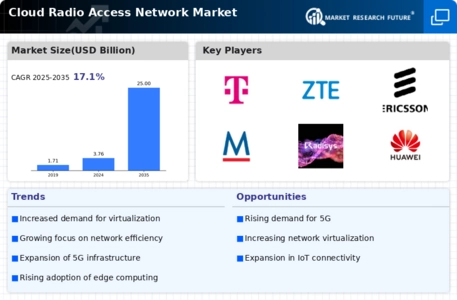Top Industry Leaders in the Cloud Radio Access Network Market

The Cloud Radio Access Network (C-RAN) Market: Competitive Landscape Analysis
The cloud radio access network (C-RAN) market is on fire, its flames fueled by the insatiable demand for enhanced 5G and future 6G mobile connectivity. This burgeoning landscape boasts a diverse cast of players, each jockeying for position in a market projected to reach a staggering growth by 2028. Let's dissect the intricate dynamics of this market, examining key players, market share factors, investment trends, and the emergence of new contenders.
Key Players:
- Agilent Technologies (U.S.)
- Alcatel-Lucent S.A. (France)
- International Business Machines Corporation (U.S.)
- Intel (U.S.)
- Ericsson (Sweden)
- Huawei Technologies Co. Ltd. (China)
- Hitachi Ltd. (Japan)
- Panasonic Corporation (Japan)
- ZTE Corporation (China)
- Xilinx Inc. (U.S.)
- NEC Corporation (Japan)
Market Share Analysis Factors:
-
Technology Leadership: Offering cutting-edge C-RAN architectures, efficient virtualized radio resources, and seamless integration with existing networks and cloud platforms are crucial for market dominance.
-
Ecosystem Collaboration: Building strong partnerships with hardware vendors, cloud providers, and software vendors expands reach and facilitates solution adoption.
-
Deployment Flexibility: Supporting both centralized and distributed C-RAN deployment models broadens the addressable market and caters to diverse MNO needs.
-
Cost-Effectiveness: Delivering optimized solutions that reduce CapEx and OpEx for MNOs is a key differentiator, especially in cost-sensitive markets.
New Entrants and Emerging Technologies:
The C-RAN market is constantly evolving, with innovation and disruption on the horizon. Notable examples include:
-
Artificial Intelligence (AI) and Machine Learning (ML): Integrating AI and ML for network optimization, fault prediction, and resource allocation promises efficient C-RAN operations and improved network performance.
-
Edge Computing: Deploying intelligent edge infrastructure for real-time data processing at the network edge will be crucial for supporting latency-sensitive applications like autonomous vehicles and augmented reality.
-
Private C-RAN Networks: Enterprises and industries demanding dedicated, ultra-secure networks are driving the adoption of private C-RAN deployments, further diversifying the market.
Current Investment Trends:
-
Venture Capital: VC firms are pouring money into promising C-RAN startups, recognizing the vast market potential and disruptive potential of open-source and software-driven solutions.
-
M&A Activity: Strategic acquisitions are on the rise, with established players looking to acquire niche technologies, regional expertise, and talent to bolster their offerings and diversify their market reach.
-
Government Initiatives: Governments worldwide are actively promoting C-RAN adoption through subsidies, funding research, and establishing open C-RAN standards, further accelerating market growth.
The Road Ahead:
The C-RAN market is a high-stakes game with immense potential. Continuous innovation, open collaboration, and flexible deployment models will be key for success. New entrants with specialized technologies and disruptive approaches will challenge established players, making the competitive landscape even more dynamic. As investment continues to surge, the C-RAN market promises to reshape the landscape of mobile communication, enabling faster, more efficient, and more flexible networks for the future.
Latest Company Updates:
-
December 5, 2023: NEC showcases its next-generation C-RAN solution with advanced automation and intelligence features at MWC Las Vegas. The solution is designed to simplify network management and optimize performance.
-
January 8, 2024: Ericsson and Qualcomm collaborate on a C-RAN trial using Open RAN architecture. This collaboration aims to accelerate the development and deployment of interoperable and vendor-neutral C-RAN solutions.
-
December 12, 2023: A report by GSMA highlights the need for greater standardization and collaboration in the C-RAN ecosystem to ensure faster and more efficient deployments.

